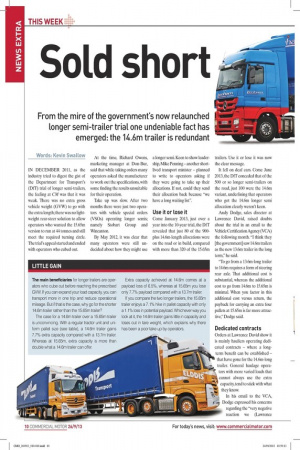Sold short
Page 8

Page 9

If you've noticed an error in this article please click here to report it so we can fix it.
From the mire of the government's now relaunched longer semi-trailer trial one undeniable fact has emerged: the 14.6m trailer is redundant Words: Kevin Swallow
IN DECEMBER 2011, as the industry tried to digest the gist of the Department for Transport's (DfT) trial of longer semi-trailers, the feeling at CM was that it was weak. There was no extra gross vehicle weight (GVVV) to go with the extra length; there was no lightweight rear-steer solution to allow operators who wanted the 15.65m version to run at 44 tonnes and still meet the required turning circle. The trial's appeal started and ended with operators who cubed out.
At the time, Richard Owens, marketing manager at Don-Bur, said that while taking orders many operators asked the manufacturer to work out the specifications, with some finding the results unsuitable for their operation.
Take up was slow. After two months there were just two operators with vehicle special orders (VS0s) operating longer semis; namely Stobart Group and Wincanton. By May 2012, it was clear that many operators were still undecided about how they might use
a longer semi. Keen to show leadership, Mike Penning — another shortlived transport minister — planned to write to operators asking if they were going to take up their allocations. If not, could they send their allocation back because "we have a long waiting list".
Use it or lose it
Come January 2013, just over a year into the 10-year trial, the DfT revealed that just 80 of the 900plus 14.6m-length allocations were on the road or in build, compared with more than 320 of the 15.65m
trailers. Use it or lose it was now the clear message.
It fell on deaf ears. Come June 2013, the DfT conceded that of the 500 or so longer semi-trailers on the road, just 100 were the 14.6m variant, underlining that operators who got the 14.6m longer semi allocation clearly weren't keen.
Andy Dodge, sales director at Lawrence David, raised doubts about the trial in an email to the Vehicle Certification Agency (VCA) the following month. "I think they [the government] saw 14.6m trailers as the new 13.6m trailer in the long term," he said.
"To go from a 13.6m-long trailer to 14.6m requires a form of steering rear axle. That additional cost is substantial, whereas the additional cost to go from 14.6m to 15.65m is minimal When you factor in this additional cost versus return, the payback for carrying an extra four pallets at 15.65m is far more attractive," Dodge said.
Dedicated contracts
Orders at Lawrence David show it is mainly hauliers operating dedicated contracts — where a longterm benefit can be established — that have gone for the 14.6m-long trailer. General haulage operators with more varied loads that
cannot always use the extra capacity, tend to stick with what they know. In his email to the VCA, Dodge expressed his concerns regarding the "very negative reaction we (Lawrence
David) are having from customers who have been allocated 14.6m licences" and operators who applied for 15.65m but ended up with some, or only, 14.6m licences. He added that the trial was in danger of going wrong if the take up on the trailers was not sufficient to obtain the required data.
Darren Holland, sales director at Cartwright Group, said most hauliers with the capacity for more payloads have taken advantage of the extra cubic capacity offered by the 15.65m variant. He thinks the government expected hauliers who come close to weighing out to use the 14.6m allocation to maximise operations. "Looking at the uptake on the trailers and the operators that are using them, it's fair to say that where the 15.65m-long trailer is being used, the
vast amount of operators would take more," said Holland. "However, the frustration comes where operators have been awarded allocations and are sitting on them and not releasing them to those who would use them."
Concession
Earlier this month, the DfT relaunched its longer semi-trailer scheme, after accepting that it was not on course to get all the original trial allocations on the road by the end of the year. In a significant concession, it has opened up the process on a first-come, first-served basis to both those in the existing trial who wish to have more longer trailers, and to those who have not been involved so far. As part of this revision, the DfT has confirmed that the market will be allowed to dictate what it wants, with operators now at liberty to choose the variant length they want until the 1,800 trial limit is reached. While this addresses Holland's concern to a degree, on current evidence, the 15.65m trailer will, overwhelmingly, be the longer trailer that operators go for. •







































